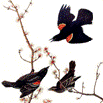Center, Internet, Wildlife Damage Management

Bird Control Seminars Proceedings
Document Type
Article
Date of this Version
November 1976
Abstract
The small African weaver finch commonly known as Quelea (Quelea quelea) has been reported (Crook and Ward, 1968) to be one of the most numerous and destructive birds in the world and is found extensively throughout Africa (DeGrazio, 1974). Quelea have been associated with damage to many agricultural crops including millet, grain sorghum, rice, and wheat. Because current population control programs in Africa have not reduced damage except in a few local areas (Crook and Ward, 1968), more effective damage control methods need to be Inves- tigated. One promising method, protection of the agricultural crop with a chemical repellent, methiocarb, has been demonstrated to be highly effective (Guarino, 1972). Small scale efficacy demonstrations in Tanzania (DeGrazio, 1974) with three pounds of methiocarb per acre to protect maturing rice and wheat have reduced Quelea damage by about 90 percent. Methiocarb is thought to produce a post-ingestional effect in the affected birds (Guarino, 1972). Rogers (1974) has presented some evidence that methiocarb, unlike a highly bitter-tasting compound (sucrose octaacetate), affects feeding activity of Red-winged Blackbirds (Ageliaus phoenlceus), but some time delay is required for affectation and subsequent feeding aversion. The development of the repellent (or aversion) response for methiocarb was similar to the aversive response shown to lithium chloride (LiCl), a salt that has been traditionally used to study conditioned aversion in rats (Nachman, 1963). This aversion effect is then thought to become quickly associated with the taste of methiocarb or treated food material (Crase and DeHaven, 1976). Schafer, Brunton, and Lockyer (1977) observed that most of the seven bird species they tested [Robins (Turdus migratorius), Brown-headed Cowbirds (Molothrus ater), White-crowned Sparrows (zonotrlchia leucophrys). House Sparrows (Passer domesticus), Starlings (sturnus vulgaris), Grackles (Quiscalus qaiscula), and Red-winged Blackbirds] displayed more food aversion and longer-lasting conditioning to methiocarb when compared with thiram (TMTD), a taste repellent. Both repellent materials were placed on food particles at levels slightly lower than the R-50 for Red-winged Blackbirds (Schafer and Brunton, 1971). To more effectively predict field application rates for protecting cereal grains from Quelea damage in Africa, we felt it necessary to compare the sensitivity of Quelea to methiocarb with sensitivities reported for other bird species (Schafer and Brunton, 1971). In addition, we wanted to determine the relative importance of taste versus visual feeding cues that could become associated with methiocarb exposure in Quelea. Knowledge gained from these studies could lead to an improved application method that would enhance the long-term repellent action of methiocarb with low level methiocarb treatments in conjunction with other stimuli. Aversive cues could also be used to alter food-searching behavior (Crase and DeHaven, 1976) so that Quelea repelled from agricultural crops would more quickly seek alternate natural foods such as grass or weed seeds and Insects.

